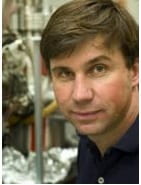
Positions
2001: Professor of Chemistry and Physics at the University of Chicago and the James Franck Institute.
1996: Associate Professor of Chemistry and Physics at the University of Chicago and the James Franck Institute.
1991: Assistant Professor of Chemistry and Physics at the University of Chicago and the James Franck Institute.
1991: Ingénieur Principal de l’Armement.
1988: Laboratoire pour l’Utilisation du Rayonnement Electromagnétique (LURE). Université Paris-Sud, Orsay, France.
Education
1983: Ecole Polytechnique, Palaiseau, France, B.S. in Engineering
1984: Université de Paris-Sud, France, M.S.(DEA) in Physics
1987: University of California at Berkeley, Ph.D. of Physics (with Y.R. Shen)
Philippe Guyot-Sionnest
Professor of Physics and Chemistry
From 1984 to 1987, as a PhD student with YR Shen, Philippe Guyot-Sionnest (PGS) started Sum Frequency Generation (SFG) surface studies with the first non-electronic resonant surface molecular vibrational spectroscopy by SFG, [1] and the first applications to liquid surfaces [2] and liquid solid interfaces [3]. From 1988 to 1991 at the University of Orsay, Paris-Sud, and with collaborators (Abderrahmane Tadjeddine, Paul Dumas, Yves Chabal), PGS performed the first SFG and infrared photon echo studies of surface vibrational dynamics [4, 5] and electrochemical systems [6].
Since 1991, the PGS group at the University of Chicago developed colloidal nanostructures. Following the seminal work by Orrit on single molecule fluorescence, the group demonstrated two-photon fluorescence microscopy of single colloidal quantum dots (CQDs) [7, 8]. Looking for a brighter and more stable single dot chromophore, the group made the breakthrough discovery of the stable and bright CdSe/ZnS core/shell CQD [9]. This core/shell approach became the basis for all brightly luminescent quantum dots and was foundational to the development of all devices using the emission properties of CQDs (see Nanocrystal Quantum Dots: From Discovery to Modern Development). The group highlighted the surface charges through new measurements of the dipole moments of CQDs [10, 11, 12], and we introduced intraband (excited state) spectroscopy of CQDs [13]. The intraband spectra led the group to discover charge transfer doping of CQDs [14, 15], and efforts to speed up the electronic response led to solid state ligand exchange [16]. The combination of controlled doping and increased electronic coupling led to the breakthrough discovery of ohmic conductivity in CQD solids [17], foundational to all devices using electronic transport in CQD solids.
The group then investigated the carrier dynamics of intraband transitions and the lack of phonon bottleneck over several years, and succeeded in showing the first instances of slow intraband relaxation in CQDs [18, 19]. During this time the group performed the first investigation of negative trion (one negative charge plus an exciton) radiative and nonradiative lifetime in CQDs [20], demonstrated electrochemical control of the single-dot photophysics[21], and investigated how the CQD structure/composition could be used to maximize the luminescence efficiency in the charged state[22, 23, 24]. This culminated in the achievement of bright charged dots [24].
In 2011, the group demonstrated mid-infrared fluorescence and photodetection with HgTe CQDs [25]. The range was extended far into the infrared to 12 microns [26], and the group obtained the first background-limited infrared detection with CQDs [27]. Mid-infrared imaging by simple drop-casting of the colloidal inks on silicon read-out chips was demonstrated [28]. Superconductivity in nanocrystal solids was also demonstrated during this time [29, 30]. The group continued to improve HgTe CQD infrared detectors[31] with performances approaching commercial devices [32], and demonstrated a dual-band CQD detector [33]. In 2014, the group discovered self-doped HgS and HgSe CQD displaying intense intraband and plasmonic transitions [34] and demonstrated intraband photodetection with CQDs [35].
Fields
Experimental, optics, condensed matter, physical chemistry, nanomaterials.
Honors
1990: Prix National des Lasers, Societé Francaise de Physique.
1992: David and Lucille Packard Foundation fellowship.
1996: Sloan Foundation fellowship
2001: American Physical Society fellow
2006: Joliot visiting professor, Ecole de Physique et Chimie Industrielle de Paris
2006: Palmes académiques
Graduate Courses Taught
Chemistry: Quantum Mechanics CHE 361, CHE 362, Materials Chemistry CHE 375, Advanced Spectroscopy CHE 371
Physics: Nonlinear Optics PHY 365, Experimental Physics PHY 334
